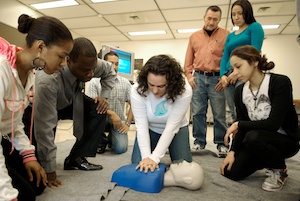
A dozen BMCC students battled snow and cold weather to get to campus one weekday morning during the winter break, and not for a winter session course, but rather to learn the latest life-saving techniques.
Almost 50 students have now taken advantage of the college’s most basic life support program, which takes place over two eight-hour sessions. Students — along with staff and faculty — learn proper skills in three different areas: first aid, CPR (Cardiopulmonary resuscitation), and AED (Automated Defibrillator Device).
The class is taught by a group of qualified Public Safety officers, including Sgt. Jesus E. Ayala, Cpl. Benoit Coumin, CPO Saded Gutierez , Cpl. Fernando Martinez, and Spc. Leonardo Zavala Salas.
Learning How to Respond
Instructors start with First Aid procedures, such as handling burns, broken bones, choking, and bleeding. After that, they focus on CPR, and how to use an AED, a portable electronic device that diagnoses a person’s cardiac situation and, if needed, delivers a shock to reboot the heart.
While instructors note that neither CPR nor an AED can completely treat a victim, by performing CPR, a responder may delay the death of the brain and heart muscle. Moreover, CPR makes the heart more likely to respond to defibrillation.
According to the instructors, once a person is hooked up to an AED, the machine will automatically lead a responder through audio prompts. Even if a patient has been successfully defibrillated, he or she is still at risk. Responders are taught to leave the AED on until emergency personnel arrive. The AED will continue to monitor the victim, and react accordingly.
Importance of the Training
Each course is taught by a pair of instructors. On this particular morning, Public Safety’s Ayala and Coumin lead the group. Ayala said that the classes have been “very interested” in the material, due to its positive impact.
“The people coming to these classes are really looking to understand these techniques,” Ayala said. “I think they realize that the training could potentially save a life, so they’re making sure they get it right.”
The course covers situations involving babies, children and adults, making it widely applicable — an important aspect, according to Coumin.
“This training can come into play anywhere. Even if you never use it at the school, you may use it at home, or at your workplace,” said Coumin.
Michelle Seppini, a first year Early Childhood Education major, said she took the course because she’s going to be surrounded by young children all day in the future.
“If I’m ever in a situation where something wrong happens, I’ll be ready to react,” she said. Seppini even mentioned eventually becoming an instructor.
“Why not give back? I seem to be good at it, it’s somewhat easy to learn, it’s very important — and I could share my knowledge with the Early Childhood Center,” she said.
After successful completion of the course, instructors issue a certificate from the National Safety Council. The certificate is good for two years — and renewal is important, Coumin said.
“The standards are always changing,” he said. “When I first learned CPR, it was 10 compressions to two breaths. Then it went to a 15 to two ratio, now it’s up to 30 to two. Plus, by repeating the certification course, you become more comfortable performing any sort of emergency response.”
While the College was able to cover costs for the first 100 students, Director of Public Safety Ed Moss said that students will now have to begin paying $25 for the training. Still, Moss added that the $25 charge is approximately $100 to $125 less than one would usually pay for this training.
Leading the Movement
Moss credited G. Scott Anderson, vice president of administration and planning at BMCC, for leading the college in its efforts to ramp up emergency preparedness.
“I think we learned on Sept. 11 — and during Hurricane Katrina, and most recently, Hurricane Ike — that we cannot always depend on emergency officials to get to us,” Anderson said.
“An emergency can happen on any floor, at any time of the day,” he said. “The staff, students and faculty are likely to be near you when anything happens. They are our first responders. And that’s the beauty of this whole program: we’ll always have someone on duty if anything happens.”
Some Take One Step Further
The combined First Aid/CPR/AED course originated at BMCC as part of training for the Campus Community Emergency Response Team (C-CERT).
C-CERT “educates people about disaster preparedness for hazards that may impact their area and trains them in basic disaster response skills, such as fire safety, light search and rescue, team organization, and disaster medical operations,” according to the program’s Web site. If local response is overwhelmed by a disaster, C-CERT members can apply what they’ve learned until help arrives; and when help does arrive, C-CERTs provide useful information to responders and support their efforts.
BMCC is one of only three colleges in the state qualified by the Federal Emergency Management Agency (FEMA) to carry out the training. But in an effort to offer a more basic training than C-CERT, BMCC made First Aid/CPR/AED its own course in September. And it may benefit C-CERT enrollment: according to the instructors, students taking the basic course might be encouraged to continue emergency training and sign up for the advanced training.
Seppinni said that her interest has been piqued, and she plans to go for C-CERT training.
“I figure, why not take advantage of what the school has to offer?” she said.
Interested?
Click here for more information on enrolling for either First Aid/CPR/AED or C-CERT training.

